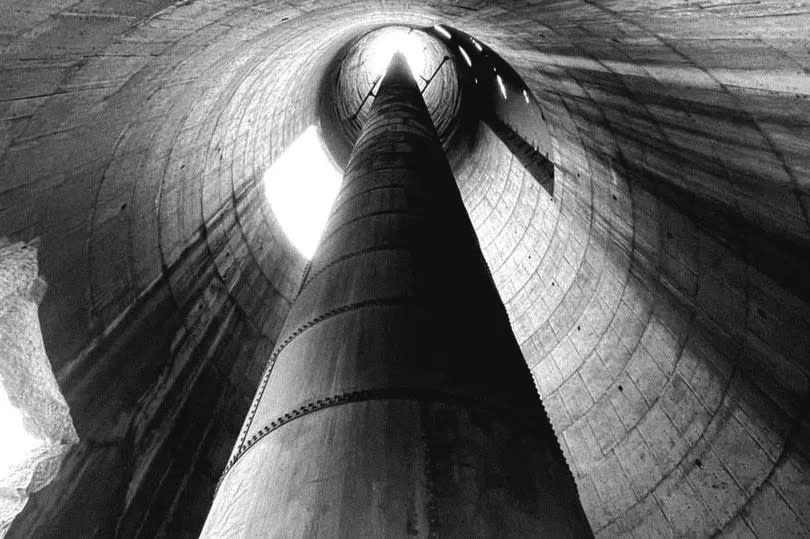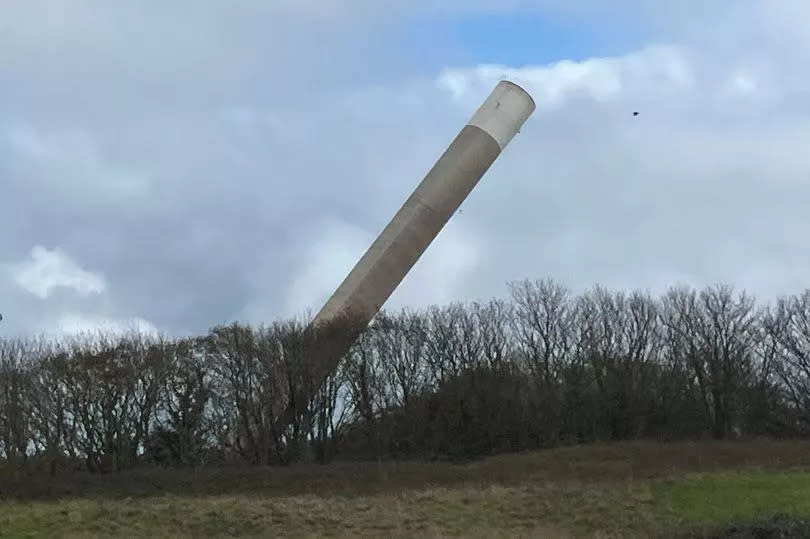Holyhead chimney demolition 'secret' ingredient that enabled 13 seconds of 'controlled chaos'
It dominated the local skyline for 50 years but was gone in 13 seconds. Holyhead’s 122m (450ft) chimney stack was one of the tallest structures in Wales before it was reduced to rubble last month.
The blow-down made national news as an era in the Anglesey port came to a dramatic end. Thousands gathered to watch the controlled explosion, which went ahead without a hitch and was carried by Nottinghamshire-based Total Reclaims Demolition (TDR).
Now the company has shared “exclusive unseen drone footage” of the event, which can be seen at the top of this page. TDR also disclosed the “secret” ingredient that brought down the concrete structure on March 20 – the date having been moved from March 1 as St David’s Day was considered “inappropriate”.
READ MORE: Welsh school on lockdown with two air ambulances at scene of major police incident - live
READ MORE: Damning photos spark anger as Anglesey's £1m red squirrels face 'tinderbox' wipeout
Given the chimney’s height, a significant amount of reinforcement was needed when it was built. This was provided by an internal steel flue, known as the Carbon Baking Stack. It meant that, for the one-time demolition to work, the entire structure first had to be pre-weakened.
A day before the blow-down, a large section of the reinforcement was cut from structure’s northwest face. As the chimney’s base was already weakened by existing doorways and openings, these formed the hinge-point for the collapse.
To enable the chimney to fall in the direction required, TDR set a window of explosives in the southeast face. A total of 156 holes were drilled in a set pattern, and each was filled with 125 grams of dynamite.
Owing to RAF Valley air space, adjacent railway lines and the proximity of the A5 and A55, both of which needed temporary closures, TRD had just a “15-minute window of opportunity” to get it done. “The secret behind the spectacular collapse?” said the contractor on social media.
“A TNT-based wonder called Perunite. This potent concoction powered the blast.” Perunite, often used in underground mining, is a type of TNT with a high denisty, high energy content and high detonation velocity. The North Wales Live Whatsapp community for top stories and breaking news is live now - here’s how to sign up

In total, 19.5kg of explosive was used – enough to blow up a house and damage the buildings around it. The pockets of Perunite were grouted and connected via 120 metres of denotation cord to a central point at the chimney’s base.
TRD told Demolition Hub Magazine: “The ignition along the length of the cord travelled at around 6,400 metres per second. That’s the equivalent of travelling from Holyhead to New York in 13 minutes.
“Once the 10-second countdown began, an eerie silence fell across the airwaves at the count of six: the final five seconds were counted in silence to keep the radio frequency free in case of an emergency.” Get the best island stories from our Anglesey newsletter - sent every Friday
Pressing the button to signal the demolition was Geraint Williams, originally from Aberffraw and now living in St Asaph. The former North Sea commercial diver won a fundraising draw that surpassed its target of £10,000 in just seven days. It took 13 seconds from the initial demolition to the chimney coming to rest in a cloud of smoke.
TRD added: “For eagle-eyed viewers, the video footage reveals the explosive pockets (of Perunite). Blink, and you’ll miss them - the very essence of controlled chaos etched into the chimney’s demise.”

The blast marked the end of 15 weeks of enabling works by the contractor at the site. Once the home of Anglesey Aluminium, the plant closed in 2013, having produced around 140,000 tonnes of aluminium each year since 1971. At the height of its operations, the site was the UK’s biggest single user of electricity, pulling in around 255mW per year.
Four smelting and storage sheds were also pulled down by TRD. These vast structures, covering around 200,000 sq ft, generated around 6,000 tonnes of scrap iron and non-ferrous metals. The land, owned by Stena Line, is being cleared to make way for new developments as part of the proposed Anglesey Freeport.
TRD added: “Following the Welsh mining tradition, on the day of its closure, the departing employees laid their boots at the entrance of the site as a silent testament to their courage and superstitions, and the dangers.”
Find out what's going on near you

 Yahoo News
Yahoo News 
